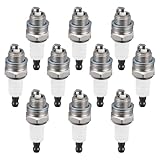Why Does My Lawn Mower Spark Plug Keep Fouling
Frustrated with your lawn mower constantly needing a new spark plug? You’re not alone. This article will explain why your lawn mower spark plug keeps fouling and offer solutions to get your mower running smoothly again.
Before we dive into the reasons why your lawn mower’s spark plug
keeps fouling, let’s understand what spark plug fouling actually is. A fouled spark plug means that the insulator and electrodes of the spark plug are covered in deposits, preventing a strong spark from forming. This leads to poor engine performance, misfires, and ultimately, a lawn mower that refuses to start.
What Causes Spark Plug Fouling?
Several factors contribute to spark plug fouling. The most common culprits include improper fuel-air mixture, oil contamination, and incorrect ignition timing. Imagine your engine as a finely tuned machine; if one component is off, it impacts the entire system. A rich fuel mixture (too much fuel) creates excessive carbon deposits on the spark plug, while a lean mixture (too little fuel) can lead to overheating and electrode erosion. Oil contamination, often due to worn engine components or a faulty PCV valve, leaves oily residue on the spark plug, inhibiting spark formation. Incorrect ignition timing can further exacerbate these issues, leading to incomplete combustion and intensified fouling. Regular maintenance, such as checking your air filter and oil level, is crucial for preventing these problems. Think of it like regular servicing for your car; neglecting it leads to bigger, more costly issues down the line.
Identifying the Symptoms of a Fouled Spark Plug
Recognizing the signs of a fouled spark plug can save you time and effort in diagnosing your lawn mower’s problems. The most obvious symptom is difficulty starting the engine or a complete failure to start. Other symptoms include rough idling, a loss of power, and sputtering or backfiring. Sometimes, you may even notice a noticeable change in the exhaust smoke color. Black or dark grey smoke frequently indicates a rich fuel mixture. This is a clear indicator that something is amiss with your engine’s fuel delivery system. You might also hear unusual sounds from the engine, such as knocking or a strange ticking noise. Paying attention to these details will help you pinpoint the source of the problem quicker. I remember once, my neighbor’s lawnmower kept sputtering and dying unexpectedly. After investigating, we found a heavily fouled spark plug. A simple replacement solved the issue immediately.
Diagnosing the Problem
Inspecting the Spark Plug
Before jumping to conclusions, it’s essential to visually inspect the spark plug itself. Carefully remove the spark plug using the appropriate socket and extension, taking care not to drop it or damage the threads. Once removed, carefully examine the insulator and electrodes. A clean spark plug will have a light tan or grayish color. Excessive black or oily deposits indicate fouling. White deposits suggest overheating, usually caused by a lean fuel-air mixture. Regularly checking your spark plug, even if your lawn mower is running well, will allow for early detection of any issues before they escalate into major engine problems. This proactive approach saves time, money, and keeps your lawn mower working at peak performance. It is much like monitoring the health of your car’s engine. Routine checks help identify potential problems early on.
Testing the Spark
After inspecting the spark plug visually, you should test its ability to create a spark. You’ll need a spark plug tester or, alternatively, you can connect a wire from the spark plug’s terminal to a good ground (like the engine block). Then, have someone crank the engine while you observe the spark gap. A healthy spark plug will produce a bright, consistent blue spark. A weak or intermittent spark signifies a problem with either the spark plug itself or the ignition system. If the spark is weak or nonexistent, it’s advisable to replace the spark plug with a new one of the correct type. It is crucial to replace with the correct type of spark plug. Incorrect specifications can cause various engine issues, potentially leading to further spark plug fouling. Always consult your lawnmower’s owner’s manual to ensure you use the right type.
Common Causes of Lawn Mower Spark Plug Fouling
Fuel-Air Mixture Problems
An incorrect fuel-air mixture is a leading cause of spark plug fouling. A rich mixture (too much fuel) leads to incomplete combustion, resulting in carbon deposits building up on the spark plug. This is often caused by a clogged air filter, a faulty carburetor, or issues with the fuel delivery system. A lean mixture (too little fuel), while less common, can also cause problems. A lean mixture can overheat the spark plug, damaging the electrodes and causing them to foul more readily. It’s similar to a car engine burning improperly; the wrong fuel-to-air ratio creates inefficiencies and potential damage. Regular cleaning or replacement of the air filter is key to maintaining the proper fuel-air mixture and preventing issues like excessive carbon buildup on the spark plug.
Ignition System Issues
Problems with the ignition system can significantly contribute to spark plug fouling. A weak spark, caused by a failing ignition coil or a worn distributor cap (in older models), leads to incomplete combustion and deposits building up on the spark plug. A faulty ignition switch or wiring issues can interrupt the electrical signal to the spark plug, leading to inconsistent or absent sparks. Just as a poorly functioning computer’s power supply can cause various malfunctions, a weak or failing ignition system in a lawnmower will impact spark delivery. This directly results in the spark plug failing to ignite the fuel-air mixture effectively. Therefore, keeping the ignition system in good working order is crucial for preventing spark plug fouling. A good quality ignition coil can be vital to your lawnmower’s long-term health and functionality.
Addressing the Problem: Solutions and Preventative Measures
Cleaning or Replacing the Spark Plug
If your inspection reveals a fouled spark plug, you can try cleaning it. Use a wire brush to carefully remove the deposits from the insulator and electrodes. However, if the fouling is severe, replacement is often the best option. Using a new spark plug ensures optimal engine performance. This is akin to replacing a worn-out car tire with a new one; while you could potentially patch up an old one, a fresh tire ensures better safety and handling. Always choose a spark plug that matches the specifications listed in your lawn mower’s owner’s manual.
Checking and Cleaning the Air Filter
A clogged air filter restricts airflow to the engine, leading to a rich fuel-air mixture and subsequent spark plug fouling. Regularly checking and cleaning or replacing the air filter is a simple preventative measure that can significantly improve your lawn mower’s performance and prolong the life of your spark plug. I learned this the hard way! My own neglect led to a fouled plug and an afternoon of troubleshooting. A few minutes to clean the air filter, though, would have avoided all that.
Maintaining Your Lawn Mower for Optimal Performance
Regular Maintenance Schedule
Establishing a regular maintenance schedule is vital for preventing spark plug fouling and other potential problems. This schedule should include tasks like checking and cleaning or replacing the air filter, inspecting the spark plug, changing the oil, and checking the fuel lines. Just like regularly servicing a car, performing these checks maintains peak performance. Think of it as proactive healthcare for your lawn mower, keeping it running smoothly and extending its lifespan. A consistent maintenance regimen can help detect and address minor issues before they turn into major repairs.
Using the Correct Fuel and Oil
Using the correct type and grade of fuel and oil is essential for optimal engine performance and preventing spark plug fouling. Using low-quality fuel or the wrong type of oil can lead to deposits forming on the spark plug and other engine components. Sticking to the manufacturer’s recommendations for fuel and oil type helps prevent issues. This is similar to using the right kind of fuel for your car—using the wrong fuel could damage the engine and require expensive repairs. Using low-quality or incorrect oil can lead to increased wear and tear on various engine components.
Advanced Troubleshooting Steps
Carburetor Adjustment
If you suspect carburetor problems (a common cause of fuel mixture issues), consider getting it professionally adjusted or cleaned. A poorly functioning carburetor can severely impact the fuel-air mixture, leading to spark plug fouling. This is a more complex step, but if other troubleshooting doesn’t resolve the issue, a professional evaluation of the carburetor might be necessary. A mechanic can adjust the carburetor to ensure the correct fuel-air ratio is delivered to the engine.
Ignition System Components
If spark plug fouling persists despite checking the spark plug and air filter, consider investigating the ignition system. A weak spark can stem from a failing ignition coil or wiring problems. Testing the ignition coil and inspecting the wiring for damage are essential steps. If any parts are damaged, replacing them can significantly improve the engine’s operation and prevent further spark plug fouling. You might need a multimeter to check voltage and resistance in the ignition system, ensuring everything is operating correctly. Consult a repair manual or professional for specific testing procedures.
Frequently Asked Questions
What type of spark plug should I use for my lawn mower?
Always consult your lawn mower’s owner’s manual to determine the correct spark plug type. The manual specifies the correct heat range, thread size, and reach for your specific engine model. Using the wrong spark plug can lead to poor engine performance and increased fouling.
How often should I replace my lawn mower spark plug?
The recommended replacement interval for lawn mower spark plugs varies depending on the model and usage. However, a good rule of thumb is to replace the spark plug every year or every 100 hours of operation, whichever comes first. Regular inspection is also crucial, even if it hasn’t reached the recommended replacement time.
Can I clean a fouled spark plug and reuse it?
While you can try cleaning a mildly fouled spark plug, it’s often more effective to replace it. Severe fouling may indicate underlying engine problems that cleaning won’t address. Replacing with a new plug ensures optimal performance and prevents recurring issues. A new plug ensures the correct spark gap and electrode condition, preventing potential engine damage.
What does a white spark plug indicate?
A white or very light-colored spark plug often indicates overheating, usually due to a lean fuel mixture. This means the engine isn’t getting enough fuel. Address this by checking your carburetor, fuel lines, and air filter. If you need to adjust your carburetor, ensure it is set to deliver the correct fuel/air mix. Otherwise, consult a professional mechanic for this potentially complicated repair.
My lawn mower is still not running after replacing the spark plug. What should I do?
If your lawn mower still isn’t running after a spark plug replacement, there’s likely another underlying issue. Start by checking the fuel system (fuel tank, fuel lines, carburetor) and then examine the ignition system (ignition coil, wiring). You might also want to check the air filter or consult the owner’s manual for further diagnostics and potential problems. If you’re not comfortable troubleshooting these components yourself, consult a small engine repair professional.
How much does it cost to replace a lawn mower spark plug?
The cost of a replacement spark plug is relatively inexpensive. You can typically find replacement spark plugs at most hardware stores or online retailers for a few dollars. The cost will vary based on the brand and specific type. The cost of labor for installation is dependent on whether you do it yourself or hire a mechanic.
Final Thoughts
Addressing why your lawn mower spark plug keeps fouling involves a multi-faceted approach that combines understanding the underlying causes, performing thorough inspections, and taking preventative measures. From identifying the symptoms and inspecting the spark plug to cleaning or replacing it, addressing fuel-air mixture problems, and maintaining your lawn mower regularly, we’ve covered a range of solutions. Remember, regular maintenance is key to preventing future issues. By following these guidelines, you can keep your lawn mower running smoothly and avoid the frustration of constantly replacing fouled spark plugs. Keep your lawn looking pristine and your weekends productive!

David Peterson, the chief editor of sparepartscare. I am an automobile engineer and assign to an local firm with much experience in automobile equipment. During the time, most of my experience is related to the Industry of cars parts. I learned about the thing, when working with experienced inspectors, one must be as good as the inspector, or better, with knowledge of the project as well as the practical aspects of automobile industry.












